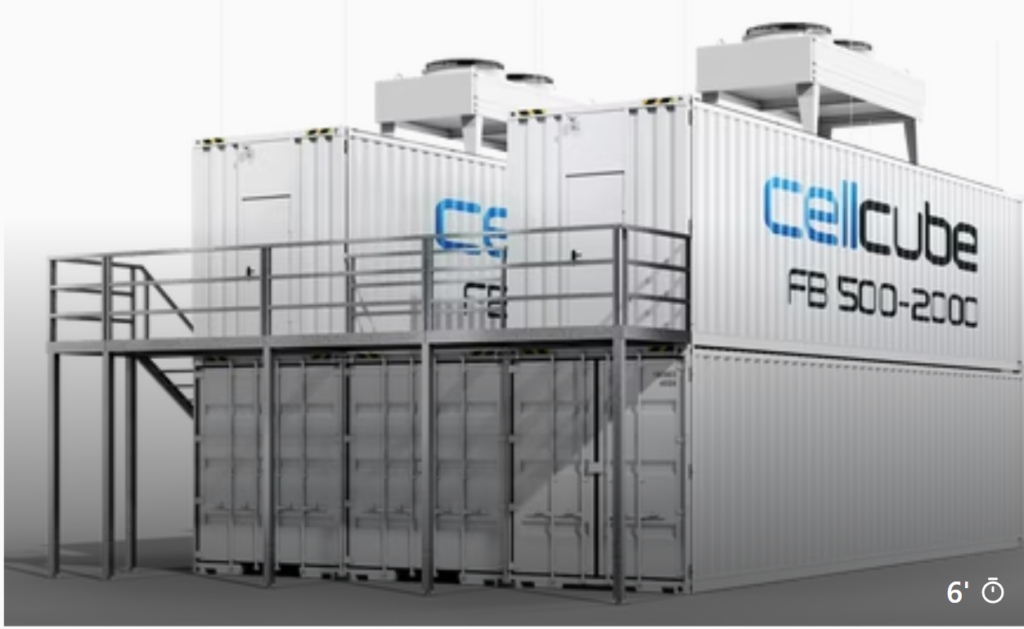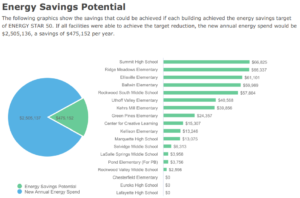
Flow batteries sport a number of advantages compared to lithium-ion batteries, including the ability to restart quickly after being idled for long periods of time.
Published2 days ago
Russia’s murderous rampage through Ukraine has given the world yet another reason to adopt a decentralized, decarbonized energy profile as quickly as possible. More long duration energy storage would help speed things along. Pumped hydro currently dominates the long duration field, but vanadium flow batteries are finally breaking through the clutter to go where pumped hydro cannot.
Vanadium Flow Batteries For Long Duration Energy Storage
Flow batteries operate on the ability of two different species of liquids to generate electricity when they flow adjacent to each other. The long duration energy storage angle follows naturally, because the tanks that store the liquids can be sized up or down to meet capacity needs.
Flow batteries sport a number of advantages compared to lithium-ion batteries, including the ability to restart quickly after being idled for long periods of time. However, there is also a catch. If the two liquids contaminate each other, the battery degrades or destabilizes.
Vanadium resolves that issue to some extent. Vanadium is a silvery gray transition metal — not to be confused with vibranium — that can be used in both species of liquids in a flow battery.
Flow battery engineering is not nearly as simple as it sounds. The technology has been around since the 1980s, but it eluded commercialization for many years.
“Though considered a promising large-scale energy storage device, the vanadium redox battery’s use has been limited by its inability to work well in a wide range of temperatures and its high cost,” researchers at the Pacific Northwest National Laboratory explained as recently as 2011. They also noted that tweaks to the electrolyte solution would make a significant difference.
Building A Better Vanadium Flow Battery
Sure enough, in 2014 a next-generation vanadium flow battery from the German firm CellCube (aka Enerox GmbH) sailed across the CleanTechnica radar, when the New York City Metropolitan Transit Authority installed three new flow batteries at its Manhattan headquarters.
That particular project dropped right off the CleanTechnica radar again, but flow battery R&D has continued apace, and CellCube has been pushing the global envelope.
The latest news from CellCube involves a newly signed Strategic Manufacturing Cooperation Agreement with the Australian firm North Harbour Clean Energy PTY Ltd. If all goes according to plan, the partners will construct a manufacturing facility at a location to be determined in Eastern Australia. The initial goal is a production capacity of 40-160 megawatt-hours per year, towards a target of up to 8,000 megawatt-hours.
Meanwhile, the partners have agreed to develop the largest vanadium flow battery on the Australian continent, aiming for a range of 4-16 megawatt-hours. The new flow battery will be demonstrated with a partner to be named later. The aim is to showcase how long duration energy storage can reduce the carbon footprint of hard-to-decarbonize industries.
As for why not simply scale up conventional lithium-ion batteries to do the same job, that’s a good question.
“[Vanadium Redox Flow Batteries] do not suffer from the multiple issues faced with lithium-ion batteries (LIBs) such as their flammable nature, short life span, rapid degradation, lack of recyclability and lack of flexibility,” CellCube explains. “On a levelised cost of storage basis, VRFBs already outperform LIBs whilst having none of the drawbacks associated with them.”
Long Duration Energy Storage, Beyond Pumped Hydro
The other question is, why not simply build more pumped hydro long duration energy storage systems? Pumped hydro is a reliable, century-old technology that continues to dominate the long duration field, here in the US and elsewhere.
For an answer to that, consider the perspective of North Harbour Clean Energy. The company specializes in pumped hydro energy storage, and the Australian government is supportive of constructing additional pumped hydro facilities.
Nevertheless, North Harbour is eyeballing the growing demand for long duration energy storage systems, beyond pumped hydro.
“There is significant demand for long duration energy storage systems such as VRFBs to allow for 24/7 delivery of carbon free electricity to meet net-zero goals driven by the demand to meet Australia’s legislated carbon reduction targets and the rapid build out of utility-scale variable renewable energy together with the accelerated shutdown of baseload coal-fired generators,” the company observes.
Beyond Long Duration Energy Storage
Flow battery technology presents a sharp contrast with lithium-ion batteries, but the two fields do have one thing in common, and that is developing a reliable, sustainable supply chain for the material that defines them.
Australia has become the leading exporter of lithium, but it also has around 20% of known global vanadium resources, according to CellCube. That provides Australia with a built-in advantage for developing a domestic flow battery industry.
The competition for vanadium resources could heat up as researchers uncover more uses beyond energy storage. Here in the US, for example, a team at Lawrence Berkeley National Laboratory is deploying the phase-changing ability of vanadium to create a new energy efficient roof coating.
Researchers are also kicking around the idea of powering electric vehicles with flow batteries. That may seem a bit futuristic, but a new flow battery for EVs is getting attention from the US Department of Defense through its cutting edge technology funding office, DARPA, better knows as the birth parent of the Internet. The US Air Force and NASA have also provided funding for the new battery.
A vanadium supply crunch could have the effect of boosting the case for more pumped hydro, though growth in that field can be limited by the environmental impact of constructing new reservoirs. The cost of constructing new water-based energy infrastructure is another limiting factor.
One way to expand the pumped hydro field without necessarily running into those issues would be to take water out of the equation. Gravity does all the heavy lifting in a pumped hydro system, and the race is on to engineer other gravity-based systems that provide long duration energy storage without having to build new reservoirs.
In one particularly interesting example, the Swiss firm Energy Vault is adapting its block-type gravity based energy storage system to recycle old wind turbine blades.
Follow me on Twitter @TinaMCasey (for now).

